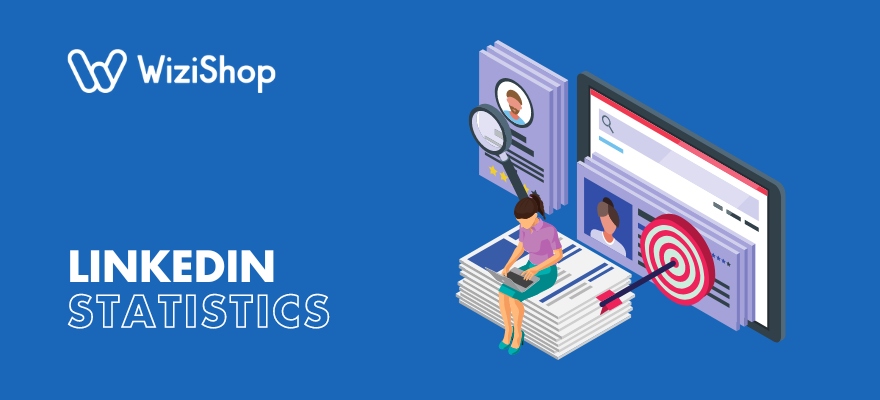Key points in this article:
- LinkedIn has surpassed 1.1 billion users worldwide across 200+ countries.
- The platform’s annual revenue reached $16.4 billion in 2024, continuing steady growth.
- 76% of users are under 35, with a strong presence of educated professionals.
- Posts with links and multi-image content drive the highest engagement.
- LinkedIn is a top choice for B2B marketing, generating 50% of traffic to B2B websites.
LinkedIn turns 22 years old in 2025! The site has made a place for itself in the world of social networks. While it may not be as popular as other social media platforms like Facebook and Instagram, it’s unique in that it allows any professional to present their business activity while promoting their skills, values, and professionalism.
This digital CV is an ideal marketing lever to acquire traffic, engagement, and visibility but also to give a boost to the user’s career. The platform also offers users the ability to find their next job or their next collaborator.
What are LinkedIn’s most important stats this year? What’s the added value of this platform for global professional networking? Keep reading to find out!
LinkedIn: Overview and key data
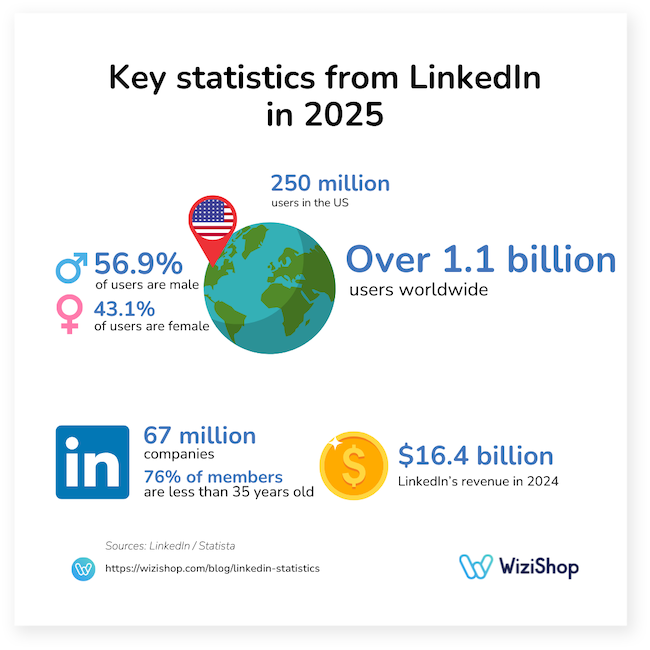
Why use LinkedIn?
Different from other social media platforms such as TikTok or Pinterest, LinkedIn is a professional social network: it allows individuals and companies to build a career-based profile as a kind of digital CV.
Like all social media platforms, LinkedIn allows users to build a network: people can add other users to increase the number of their connections, here with the aim of developing their career.
As LinkedIn user profiles can be found on search engines, LinkedIn is also a way for users to build an online presence and easily control it. Company or personal profiles are available for organizations or employees and entrepreneurs.
LinkedIn makes it possible for you to stay up to date with the latest news of your business network but also to find or offer jobs, thanks to its job platform.
What year was LinkedIn created?
LinkedIn was created in 2002 and launched in 2003 in the United States.
The social network’s co-founders are Reid Hoffman and Allen Blue, both members of the so-called “PayPal Mafia” of payment platform creators who went on to create other international companies, along with three other entrepreneurs.
To be able to evolve its service for users over time, LinkedIn extended its network worldwide in 2008 with new countries such as Spain and France. Then, in 2014, a Chinese version adapted to the country’s restrictions. LinkedIn is now present in 200 countries.
Today, the global company counts over 18,500 employees and has offices in over 30 around the world.
What is LinkedIn’s business model?
The network is based on a business model consisting of three top sources of revenue, namely advertising (sponsorship), subscriptions (premium profiles), and its recruitment service (job search engine).
In 2008, the network created its own advertising platform.
In 2016, LinkedIn was acquired by Microsoft for $26.2 billion.
Since June 2020, Ryan Roslansky has been the CEO of the network. LinkedIn's headquarters is located in Mountain View, California.
What are LinkedIn’s revenue sources?
LinkedIn’s goal is closely linked to the professional success of its subscribers. This goal is achieved on several levels, whether in the sharing of content or in the creation of professional relationships.
To do this, the site allows you to connect professionals with each other, as well as professionals with companies and vice versa. In addition, recruiters can post job offers on LinkedIn.
Advertising is also a source of revenue for LinkedIn. Thanks to its large database, ads on the social network are ultra-targeted and very effective, which makes this service a popular acquisition lever.
LinkedIn has set up different offers to allow users and businesses to take advantage of the services according to their needs:
- Premium Career: to be able to be recruited and develop your career ($29.99 per month)
- Premium Business: for companies to develop their business ($59.99 per month)
- Sales Navigator Core: to increase your number of leads and grow your customer base ($99.99 per month)
- Recruiter Lite: for recruiters to find more talent ($170 per month)
- LinkedIn Learning: to train and improve your skills ($19.99 per month with a one-year commitment or $39.99 per month with no commitment)
According to Kinsta, 39% of LinkedIn users pay for a subscription.
What is LinkedIn’s annual revenue?
Intelpoint states that LinkedIn’s revenue doubled from 2017 to 2018, going from $2.3 billion to $5.3 billion, and increased to $6.8 billion in 2019. The company’s revenue experienced growth of approximately 68% between 2020 and 2022, expanding from $8.1 billion to $13.6 billion, and amounted to $15 billion in 2023.
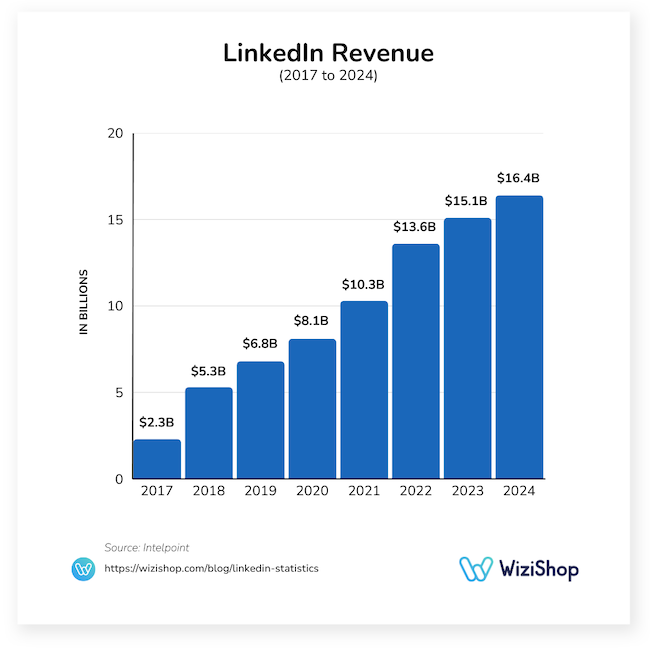
In 2024, LinkedIn’s revenue reached $16.4 billion.
Key global LinkedIn usage stats and user demographics
LinkedIn is one of the essential social networks for all professionals and businesses. Who makes up the network’s audience and what's the target of this career accelerator based on the data?
How many LinkedIn users are there?
In 2025, LinkedIn has more than 1.1 billion users worldwide in 200 countries and territories.
Statista forecasts a 22% increase in the LinkedIn population between 2024 and 2028.
Studies estimate that monthly active users represent around 50% of LinkedIn members.
According to Statista’s LinkedIn data for February 2025, in terms of gender demographics, 56.9% of members are male and 43.1% are female.
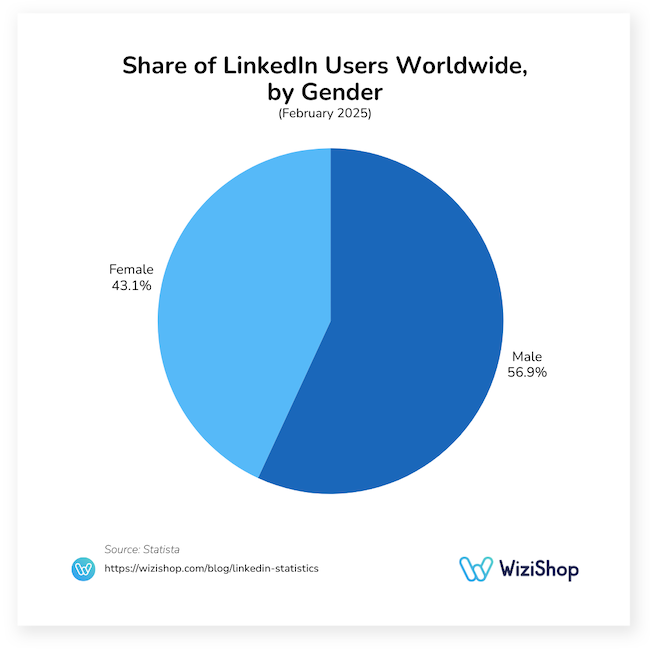
Which regions use LinkedIn the most worldwide?
Intelpoint reports that as of January 2025, the region with the most people using the LinkedIn platform is Northern America, with 277 million users.
This is followed by Southern Asia (180 million users), Southern America (148 million users), South-Eastern Asia (82.8 million users), and Western Europe (81.9 million users).
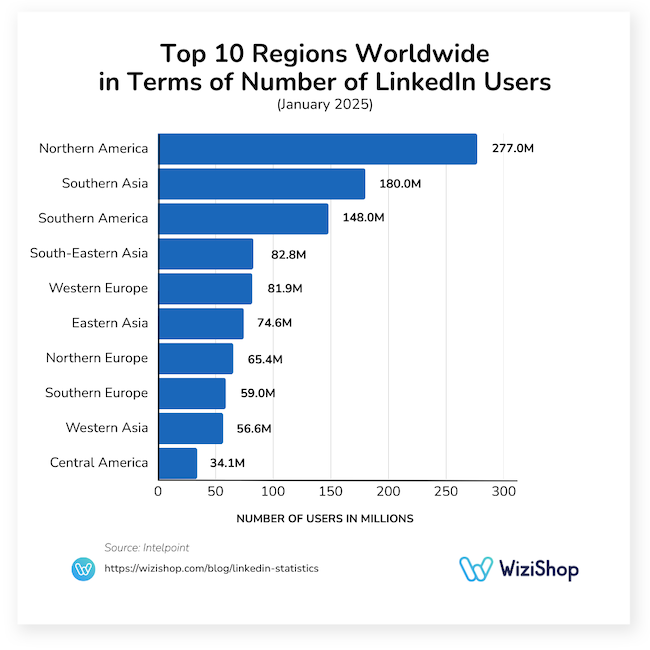
The following table displays the share of global users for these regions with the greatest number of LinkedIn users:
| Region | Share of global users |
|---|---|
| Northern America | 23.1% |
| Southern Asia | 15.0% |
| Southern America | 12.3% |
| South-Eastern Asia | 6.9% |
| Western Europe | 6.8% |
| Eastern Asia | 6.2% |
| Northern Europe | 5.4% |
| Southern Europe | 4.9% |
| Western Asia | 4.7% |
| Central America | 2.8% |
Source: Intelpoint
In which countries do LinkedIn ads reach the greatest number of users?
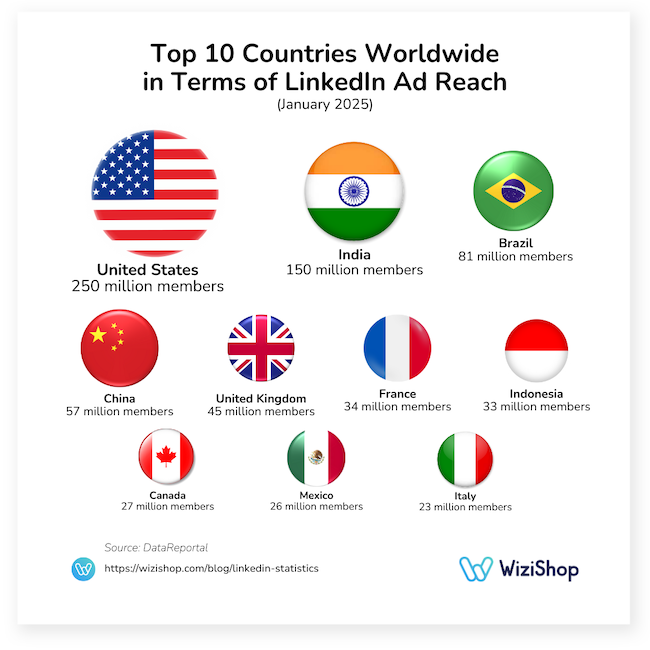
Based on January 2025 data from DataReportal, the Top 10 countries when it comes to LinkedIn ad reach are as follows:
| Country | Number of LinkedIn members |
|---|---|
| United States | 250 million |
| India | 150 million |
| Brazil | 81 million |
| China | 57 million |
| United Kingdom | 45 million |
| France | 34 million |
| Indonesia | 33 million |
| Canada | 27 million |
| Mexico | 26 million |
| Italy | 23 million |
Source: DataReportal
What level of education do LinkedIn users have?
Taking a closer look at users based in the United States, where the greatest distribution of LinkedIn users can be found, it seems that the social media platform is particularly popular among Americans who have attained a higher level of formal education.
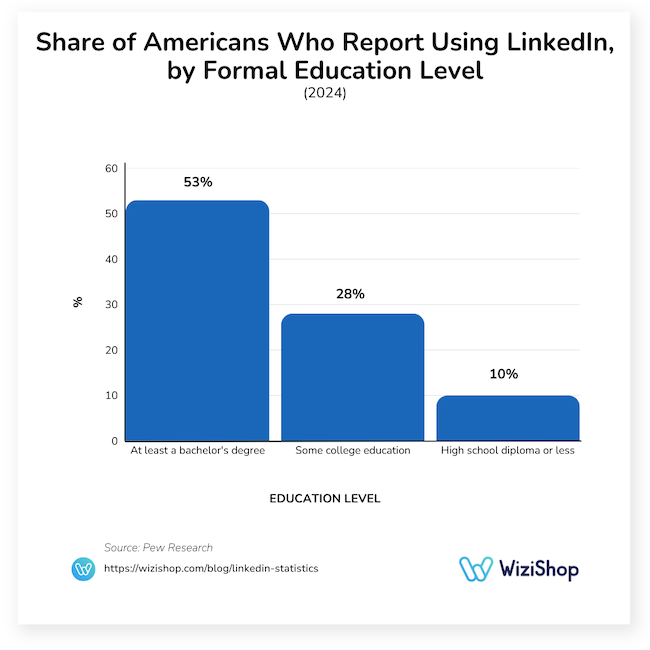
Based on data from Pew Research: 53% of Americans who have obtained a bachelor’s degree or higher report using the platform, which is significantly greater compared to 28% of those falling into the group with some college education and just 10% of those with a high school diploma or less.
Which generation uses LinkedIn the most? What age group is most present?
Regarding LinkedIn users worldwide, Gen Z and millennials make up the largest groups of users on the platform. Here’s the following distribution of users per age range as of February 2025:
| Age group | Share of LinkedIn users |
|---|---|
| 18–24 years old | 28.7% |
| 25–34 years old | 47.3% |
| 35–54 years old | 20.7% |
| 55+ years old | 3.3% |
Source: DataReportal
It’s worth noting that 76% of LinkedIn members are under the age of 35.
How often do people use LinkedIn?
Based on Statista data, 16.2% of users in the United States access the platform every day, while 48.5% of them log in at least once a month, as of March 2021.
How many people use LinkedIn to search for jobs?
If your business is in the process of recruiting, leveraging your LinkedIn company page could be a vital tool for attracting new talent. LinkedIn’s own stats reveal that each week, 49 million individuals use the platform to explore job opportunities.
In addition, with 41,000+ skills cataloged on LinkedIn, it serves as an outstanding platform for employers seeking the ideal candidate for a job post.
How many users have activated creator mode on LinkedIn?
Introduced in 2021, LinkedIn’s creator mode has gradually been gathering momentum, with more than 11 million members turning on this feature since its launch.
This mode enables users to highlight their content and boost their profile visibility on the platform, proving to be an essential asset for individuals aiming to enhance their brand or professional standing.
How to use LinkedIn effectively as a business
In order for your company to have the greatest possible visibility and the best performance on the social network, let’s take a look at how businesses can create top content and track the results of their posts in an optimal way.
What’s a good engagement rate on LinkedIn?
This is the key statistic that will help you to know if your posts will perform well: reactions, likes, comments, and shares are compared to the number of an account’s subscribers to evaluate this rate.
A good engagement rate for people to aim for with their posts on LinkedIn is 3% or higher. It’s interesting to note that this figure has increased by 44% from 2023 to 2024, according to SocialInsider.
What type of content should you create on LinkedIn?
First of all, before delving into the key content to create, it's important to bear in mind the following statistic: 70% of users consult LinkedIn on a mobile device, as determined by Analyzify.
It will therefore be essential that any content you share on the platform is displayed well on all devices.
As far as what type of content may get you the most engagement on LinkedIn, multi-image posts take the #1 spot, with an average engagement rate of 6.60%.
The following table details the average engagement rate for various types of content formats on LinkedIn, as reported by SocialInsider:
| Content format | Average engagement rate |
|---|---|
| Multi-image | 6.60% |
| Native document | 6.10% |
| Video | 5.60% |
| Image | 4.85% |
| Poll | 4.40% |
| Text | 4.00% |
Source: SocialInsider
In addition, LinkedIn states that posts including a link record 45% more engagement.
If you opt to share articles with your audience on the platform, note that the best-performing titles are 40 to 49 characters long (OkDork).
Video content is quickly becoming more popular on LinkedIn, especially with B2B marketing, with 78% of B2B marketers already sharing videos on the social network, according to LinkedIn.
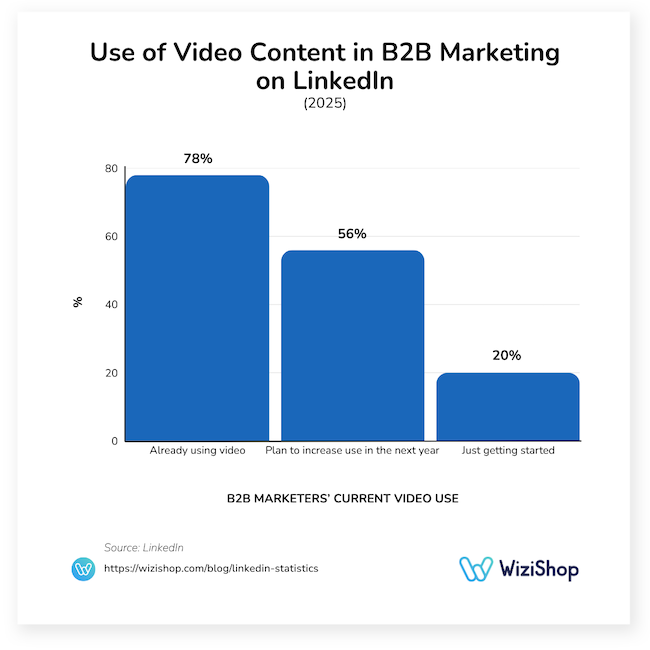
What’s more, more than half of respondents intend to boost their use of video content in the next year.
It’s also possible to create your own LinkedIn marketing newsletter to improve your reach and grow your audience: there were 150 million email subscriptions in the first quarter of 2023.
How often should your business post on LinkedIn?
Many companies and marketers are beginning to understand the importance of Metricool reports that the average posting rate for brands on LinkedIn is 18 times per month, which translates to about 4.5 times per week.
If you’re currently posting on the platform much less frequently, the following Buffer statistics may be an incentive to boost your content marketing efforts and post more often to reach your goals on the platform more quickly:
- Posting 2 to 5 times weekly can lead to 1,182 more impressions and a 0.23% greater engagement rate per post.
- Posting 6 to 10 times weekly can lead to 5,001 more impressions and a 0.76% greater engagement rate per post.
- Posting 11+ times weekly can lead to almost 17,000 more impressions and a 1.4% greater engagement rate per post.
Why should a company be on LinkedIn?
LinkedIn’s research has counted over 69 million companies on the platform and more than 141,000 schools.
While businesses of all kinds can be found on LinkedIn, B2B businesses have a much larger presence than B2C businesses. In fact, data from Straits Research found that 96% of B2B marketers had a preference for LinkedIn, compared to 9% of B2C marketers.
Where can you find your company statistics on LinkedIn?
To access your LinkedIn Page’s essential weekly, daily, or monthly business reporting statistics, you must first be designated as a Page “admin.”
As a LinkedIn Page admin, exploring your Page's performance is made easier by analyzing it.
To view your Page statistics:
- Go to your Page administrator interface.
- Select “Analytics” from the left-hand menu.
- Choose from the options (content, visitors, followers, leads, etc.).
How do you make your B2B profile stand out on LinkedIn?
To reach as many people as possible, the current strategy for B2B marketers to undertake is that of massive information sharing through their brand page but also and especially through their collaborators’ accounts.
Omnicore states that 50% of all traffic to B2B websites and blogs is generated by sharing links on LinkedIn.
In order to get the most user reactions possible to your LinkedIn posts, the top marketing strategy you should have for your organic posts is to share captivating, informative, and well-adapted content with the users in your target audience. The more time users spend on your posts, the more your profile will be highlighted on the platform: this is called “dwell time.”
In addition, as a professional, you may need new collaborators or solutions adapted to your needs: by highlighting your content and your values on LinkedIn, you’ll allow your business to shine and attract the attention of entities that’ll be able to help you develop your business on a global scale.
You can also tag third-party accounts to encourage them to share your posts and therefore gain visibility with other people on the LinkedIn social media platform.
Once you have your native content strategy in place, why not consider advertising to users?
How can marketers advertise well on LinkedIn?
According to Hootsuite in 2023, LinkedIn advertising can reach up to 14.6% of the global population.
In addition, Hootsuite notes the most effective ad formats for marketers to implement into their social media marketing strategy concerning LinkedIn ads:
- Live stream: This format can get you 7x more reactions and 24x more comments than regular video posts.
- Images: Posts with images receive 2x more engagement.
- Sponsored posts: A favorite with marketers, who have noted a 33% increase in purchase intent thanks to advertisements, at the start of the sales funnel.
- Lead-generation ads: 19% of marketers believe these lead generators that allow you to expand your database to be the best ad format on the platform.
- Sponsored inMail ads: 5% of marketers have a preference for sponsored direct messages, which have an open rate of 52% on average.
- Text ads and dynamic ads: 4% of marketers think text-based inserts are the best format for advertising on LinkedIn, while only 1% of them think that dynamic advertisements are an effective way to help grow your subscriber base.
Conclusion
LinkedIn continues to stand out as a pivotal tool in the professional world, demonstrating substantial growth and engagement among users globally. The statistics presented underscore its value not only for networking but also for branding, recruitment, and marketing strategies.
As LinkedIn evolves, understanding these trends is crucial for professionals and companies aiming to maximize their presence and opportunities in this dynamic professional landscape. Embracing these insights can lead to enhanced connectivity, visibility, and success in the professional realm.
It’s more critical than ever to invest in LinkedIn to legitimize your business or professional activity, grow your network, strengthen customer relationships, and open doors and new horizons for the future!
Want to boost your knowledge of social network stats further? Be sure to check our other articles:


